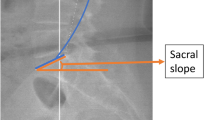Abstract
Purpose
Residual feeling of leg length discrepancy (LLD) is a common cause of patient dissatisfaction following total hip arthroplasty (THA). The purpose of this study is to propose a method for determining an optimal leg length correction goal in THA.
Methods
We conducted a retrospective study of 132 patients to examine the radiographic LLD (R-LLD), perceived LLD (P-LLD), and whether or not the patient has an uncomfortable feeling about the leg length after THA.
Results
The residual discomfort rate in all patients was 9.1% (12/132 patients), and ten of these 12 patients felt uncomfortable due to a longer leg length. When R-LLD was within 7 mm, the rate was 6.8% (8/118 patients), which is nearly equal to the rate of 7.8% (5/64 patients) in cases in which R-LLD was within 2 mm. On the other hand, when R-LLD was 8 mm or more, the rate was 57.1% (4/7 patients).
Conclusions
The results of our study show that 7 mm may be a reasonable threshold for reducing the residual discomfort. However, even with little or no R-LLD, some patients will continue to experience discomfort. We think that this is because of pre-operative differences between R-LLD and P-LLD in such cases. If the patient has a pelvic declination on the affected hip side and a lumbar scoliosis angle that is convex toward the affected hip side before surgery, the ideal length may be a little shorter than the radiographic isometry, since such patients are likely to feel a longer leg length than that shown radiographically.





Similar content being viewed by others
References
Upadhyay A, York S, Macaulay W, McGrory B, Robbennolt J, Bal BS (2007) Medical malpractice in hip and knee arthroplasty. J Arthroplast 22(6 Suppl 2):2–7
Wylde V, Whitehouse SL, Taylor AH, Pattison GT, Bannister GC, Blom AW (2009) Prevalence and functional impact of patient-perceived leg length discrepancy after hip replacement. Int Orthop 33(4):905–909
Koga D, Jinno T, Okawa A, Morita S, Shinomiya K (2009) The effect of preoperative lateral flexibility of the lumbar spine on perceived leg length discrepancy after total hip arthroplasty. J Med Dent Sci 56(1):69–77
Kabata T, Kajino Y, Inoue D, Ohmori T, Yoshitani J, Ueno T, Ueoka K, Tsuchiya H (2019) Safety range for acute limb lengthening in primary total hip arthroplasty. Int Orthop 43(9):2047–2056
Komiyama K, Fukushi JI, Motomura G, Hamai S, Ikemura S, Fujii M, Nakashima Y (2019) Does high hip centre affect dislocation after total hip arthroplasty for developmental dysplasia of the hip? Int Orthop 43(9):2057–2063
Kuroda K, Kabata T, Maeda T, Kajino Y, Tsuchiya H (2014) Do we need intraoperative radiographs for positioning the femoral component in total hip arthroplasty? Arch Orthop Trauma Surg 134(5):727–733
Woolson ST, Harris WH (1985) A method of intraoperative limb length measurement in total hip arthroplasty. Clin Orthop Relat Res 194(194):207–210
Edeen J, Sharkey PF, Alexander AH (1995) Clinical significance of leg-length inequality after total hip arthroplasty. Am J Orthop (Belle Mead NJ) 24(4):347–351
Röder C, Vogel R, Burri L, Dietrich D, Staub LP (2012) Total hip arthroplasty: leg length inequality impairs functional outcomes and patient satisfaction. BMC Musculoskelet Disord 13:95
Pakpianpairoj C (2012) Perception of leg length discrepancy after total hip replacement and its impact on quality of life. J Med Assoc Thail 95(Suppl 10):S105–S108
Whitehouse MR, Stefanovich-Lawbuary NS, Brunton LR, Blom AW (2013) The impact of leg length discrepancy on patient satisfaction and functional outcome following total hip arthroplasty. J Arthroplast 28(8):1408–1414
White TO, Dougall TW (2002) Arthroplasty of the hip. Leg length is not important. J Bone Joint Surg Br 84(3):335–338
McWilliams AB, Grainger AJ, O’Connor PJ, Redmond AC, Stewart TD, Stone MH (2013) A review of symptomatic leg length inequality following total hip arthroplasty. Hip Int 23(1):6–14
O’Brien S, Kernohan G, Fitzpatrick C, Hill J, Beverland D (2010) Perception of imposed leg length inequality in normal subjects. Hip Int 20(4):505–511
Ng VY, Kean JR, Glassman AH (2013) Limb-length discrepancy after hip arthroplasty. J Bone Joint Surg Am 95(15):1426–1436
Sykes A, Hill J, Orr J, Humphreys P, Rooney A, Morrow E, Beverland D (2015) Patients’ perception of leg length discrepancy post total hip arthroplasty. Hip Int 25(5):452–456
Civinini R, Cozzi Lepri A, Carulli C, Matassi F, Villano M, Innocenti M (2019) The anterior-based muscle-sparing approach to the hip: the “other” anterior approach to the hip. Int Orthop 43(1):47–53
Erivan R, Muller AS, Villatte G, Millerioux S, Mulliez A, Boisgard S, Descamps S (2019) Short stems reproduce femoral offset better than standard stems in total hip arthroplasty: a case-control study. Int Orthop
Ranawat CS, Rodriguez JA (1997) Functional leg-length inequality following total hip arthroplasty. J Arthroplast 12(4):359–364
Author information
Authors and Affiliations
Corresponding author
Ethics declarations
Conflict of interest
The authors declare that they have no conflict of interest.
Ethical review committee statement
This investigational protocol was conducted with the approval of the Kanazawa University Graduate School of Medicine Ethics Committee. In accordance with the requirements of this review, all subjects provided informed consent.
Additional information
Publisher’s note
Springer Nature remains neutral with regard to jurisdictional claims in published maps and institutional affiliations.
Rights and permissions
About this article
Cite this article
Fujita, K., Kabata, T., Kajino, Y. et al. Optimizing leg length correction in total hip arthroplasty. International Orthopaedics (SICOT) 44, 437–443 (2020). https://doi.org/10.1007/s00264-019-04411-0
Received:
Accepted:
Published:
Issue Date:
DOI: https://doi.org/10.1007/s00264-019-04411-0




